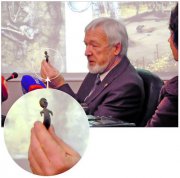 In 2011, archeologists found such artifacts in Siberia, that even the Hermitage and Louvre are envious.
In 2011, archeologists found such artifacts in Siberia, that even the Hermitage and Louvre are envious.
In 2011, scientists from Institute of Archeology and Ethnography of SO RAN worked all over the world:
In Montenegro, Mongolia, Vietnam, in republics of Central Asia…but Siberia had more surprises for the scientists again. What was it, lying literally under our feet?
We walk over kurgans
Novosibirsk region is richer in artifacts than the entire Montenegro, especially Vengerskiy and Chanovskiy districts. The vice-director of Institute of Archeology and Ethnology of SO RAN, Vyacheslav Molodin will tell us about one of the finds - a tiny metal figure, which literally radiates ancientness.
- This bronze idol, made around the end of the 3rd - beginning of the 2nd millennium before our era, was found in the Tartas burial grounds in Vengerskiy district. It is literally the first object of this type to be found in Krotovskaya culture. Look at how it is made: the torso is made symbolically, but in relief, and you can distinguish facial features and headdress on the head. This is a find of such standard that the Hermitage and The Louvre would be happy to have it. Just like many of our other finds.
It is interesting that this particular burial was totally robbed and even also defiled already in ancient times, and that this little figure survived until now is a great success. Even more so because sometimes ancient artifacts are not at all destroyed by barbarians but by our own enlightened contemporaries.
Ancient stone ended up in a vegetable garden
One of monuments that is under the threat of disappearance is kurgan "Vengerovo-6". The administration of Novosibirsk region contacted Institute of Archeology and Ethnography with a request to research it as soon as possible. Just like many other burial grounds, it was not only robbed in ancient times, but was subjected to destruction in 21st century. The embankment of 30 meter diameter was taken apart by local people for their gardening needs. But Vyacheslav Molodin believes that they have done it from thoughtlessness and ignorance. On the other hand, it was their work that the research of the kurgan was quickly completed.
It turned out that there was a burial area under the kurgan, surrounded by two trenches. Judging from the condition of the two trenches, they stood open for a long time, meaning that the complex was built long before the first people were buried there. The excavations yielded many objects: pottery, weapons, arrowheads, as well as items associated with horse-riding equipment. The most remarkable find in Vyacheslav Molodin's opinion is a gold ring, brought to Siberia from thousands of kilometers away. At that time such objects were made only in the Black Sea area, in ancient Greece centers, and the ring got here from the far West. Note that archeology in Siberia began from so-called Piotrovskiy collection, with objects given to the Tsar by local rulers. It contained much gold from Siberian kurgans, and the objects in the collection were made by the same technology as this ring. So this find confirms again: very much of Tsar Peter's collection was found precisely in Western Siberia.
Gas pipelines do not bother artifacts
Beside enterprising dacha owners, strategic objects such as fuel pipelines can also be a menace to ancient kurgans.
Gas pipeline "Altai" has geopolitical significance, but its construction is not a reason to destroy ancient monuments. In 2011 archeologists followed its route and the results of the survey turned out to be very rich - 330 archeological objects were discovered in the area of the future construction. The scientists propose that the route of the pipeline is changed, so that ancient monuments are not damaged by it, or else excavations have to be done on an emergency basis.
As Vyacheslav Molodin notes, minister of emergencies of Russia, Sergei Shoigu has a very respectful attitude towards archeology. It was him who invited scientists to research the zone of construction of the railroad Abakan - Kyzyl - and it turned out not to be in vain. Quite a few medieval artifacts ended up in the collections of the institutes, that it seems as if there is a kurgan for every 10 kilometers in Siberia.
Out of three "new construction" expeditions (as Vyacheslav Molodin expressed it), the excavations in Boguchanskiy GES were the most massive. The scientists excavated 84 monuments and turned over 41,600 square meters of soil. They found several entire pottery vessels in this district, which are found only very rarely; mostly only fragments are found. There is another magnificent witness of the past - a stone dagger with a bone handle. This weapon is twice the age of Egyptian pyramids: it was made in the Neolithic era, that is in 6-7 millennium before our era. A medieval statue of an eagle does not make such a strong impression, but in the scientists' opinion it could easily be placed in any exhibition.
- We are often asked: well and why are all these expenditures necessary, why send expeditions to some remote taiga - as if there could be some culture there? - Vyacheslav Molodin tells us - In my opinion, the richest monuments which we found so far show to what extent such questions are inappropriate.
FACT
During research of Karama encampment in Altai, its age was evaluated as about 800 000 years.
NUMBER
In the archeological expeditions of institute of Archeology and Ethnography of SO RAN, 88 teams took part.

